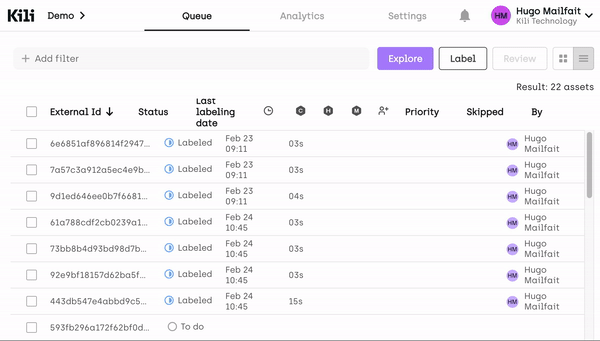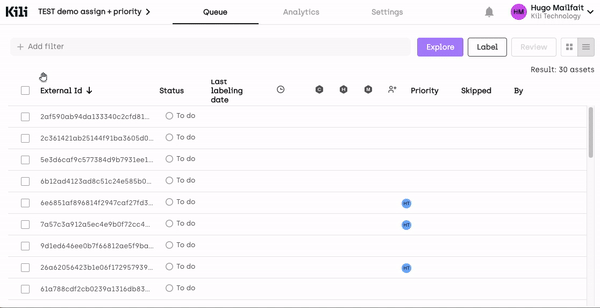Frequently asked questions
I’m getting an error when I try uploading a video to Kili. What can I do to resolve this issue?
You can find the list of video formats that are supported by Kili in our documentation.
If your format is not in the list, you can use ffmpeg to convert your video.
This tutorial will help you select the appropriate parameters for the conversion.
When I synchronize my data connection, some objects in my bucket are not detected by Kili. What is the reason?
So far, we have identified two versions of this problem:
- No objects are being detected.
403(request not authorized) error appears - Some objects located in an S3 bucket are not being detected
No objects are being detected. 403 (request not authorized) error appears.
403 (request not authorized) error appears.If none of your objects are being detected and you’re getting a 403 (request not authorized) error when triggering the synchronization, the problem is most likely caused by an issue in your integration setup.
To resolve the issue, refer to our documentation:
specifically, the sections on roles and permissions.
Some objects located in an S3 bucket are not being detected
If some of your objects that are located in an S3 bucket are not being detected, this may be caused by how the files were uploaded or moved using the Amazon SDK.
To mitigate this, when uploading or moving files to an S3 bucket, in the ExtraArgs argument, always specify the Content-Type of your file. This will ensure that the metadata does not get modified.
import boto3
s3 = boto3.resource('s3')
s3.meta.client.upload_file(
'/tmp/your-image.jpeg',
'your-bucket',
'your-jpeg.jpeg',
ExtraArgs={'ContentType': 'image/jpeg'})After I modified the interface of my project, the labels that I had started behaving strangely. How can I fix this?
Renaming jobs and/or categories after a project has started is currently not supported by Kili. The existing labels refer to the pre-change interface, so there will very likely be a mismatch.
Do not change the interface if a project is already under way.
How can I get the list of assets that were labeled today?
In the Kili interface, from the asset queue or from the explore view, click Add filter > Date > Today.

When you apply the filter, the asset queue displays only the assets that were labeled today (autosave labels are not taken into account).
You can also use the Kili SDK. Create a datetime object to define the start of the day and then call the assets query with the label_created_at_gt parameter:
from datetime import date, datetime, time
start_of_day = datetime.combine(date.today(), time(0, 0, 0)).isoformat()[:-3]
assets = kili.assets(project_id='my-project-id', label_created_at_gt=start_of_day)To check other filtering options, refer to:
I assigned an asset to a labeler and assumed that the asset would immediately show as the next to-do item for my labeler. This didn’t happen. How do I make sure that the labeler sees the assigned assets first?
Assigning assets does not impact their usual order of appearance in the labeling process. It just ensures that some assets are specifically labeled by one (or several) labelers; for example, because of their unique ability to process such assets.
To make sure that labelers annotate the newly-assigned assets first, you must prioritize the assets. You can do it either from the Kili interface, or programmatically.
Prioritizing assets from the Kili interface
From the Kili interface, select the assets and put them on top of the queue, as shown in this video:

For more information about prioritizing assets, refer to this dedicated section of our documentation.
Prioritizing assets programmatically
You can also prioritize with the Kili SDK, using the priorities parameter of the update_properties_in_assets method (for details, refer to the documentation).
Additionally, here’s a dedicated recipe that helps you assign asset priorities:
I want to change the author of a project to make it consistent with all our other projects. Is this possible?
In cases when changing a project owner is necessary, the change can be made by an administrator of the Kili platform. Here are a few additional things to consider:
- If the new author of the project belongs to your organization and is the only other ADMIN of the project in question, we will be able to make this change quickly.
- In other cases, this change would require manually editing our database, which is not a risk-free solution so we strongly advise against it.
If you still want to edit the project owner, contact [email protected].
I want to add a cloud storage integration, but my bucket contains more than 25,000 assets. Will Kili allow me to sync?
By all means, yes. However, because the asset limit per project is 25,000, Kili will only sync the first 25,000 assets from your bucket.
As a workaround, you can split the data in your bucket into multiple folders (max 25K assets each) and then filter the data connector on a specific folder for each project.
Updated about 2 months ago